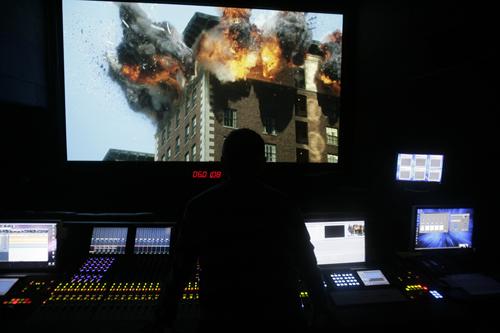Producer Dean Devlin pursues a digital future

Movie and TV producer and CEO of Electric Entertainment Dean Devlin is shown inside the screening/mixing stage room at his facility, Tuesday, Jan. 27, 2009, in Los Angeles. Ric Francis, The Associated Press
February 6, 2009
LOS ANGELES – Producer Dean Devlin likes to think big, with “Independence Day” and “Godzilla” providing the special-effects proof.
But when it comes to the future of TV and filmmaking, Devlin is convinced the answer is small – so small, it can fit into a 1930s animal hospital converted into a production facility.
On a midtown commercial block, in a two-story building still bearing a dog mascot atop its roof, Electric Entertainment is creating TV projects including TNT’s drama “Leverage” and theatrical movies.
A wholly digital approach that turns the traditional production model on its head is allowing the independent company co-owned by Devlin to finance projects without routinely relying on major studios partners.
“We do believe this is the future,” Devlin says.
Get The Daily Illini in your inbox!
Electric Entertainment’s modest home has become a tourist destination for industry insiders, with friends and colleagues like Mel Gibson and Bruce Willis and directors and producers dropping in to evaluate it for themselves.
“Where he’s going makes sense,” says actor-director Jonathan Frakes (“Star Trek: The Next Generation”), who has worked with Devlin. “He’s finding a way to eliminate the middleman in this digital world.”
The long-standing process in which film is farmed out to various outside “post houses” – postproduction firms that execute special effects and other elements – now has come inside Electric Entertainment’s doors.
A $300,000 server, the X-SAN, links each department, including sound mixing, visual effects and color timing, allowing immediate changes to projects. Producers and directors can dip in any time with alterations or suggestions, and writers are also at hand.
The streamlined result allows increased control over cost and quality, Devlin says, although he acknowledges that it’s an unwelcome shift for post houses.
A self-proclaimed geek, Devlin is an enthusiastic tour guide at his ministudio, which opened last year and lacks only sound stages for shooting. There’s artful use of space: A room that holds a 21-foot screen for final sound and image check can morph into a screening room with consoles taken out and chairs brought in.
“It’s a lot of fun. I call it Santa’s workshop,” Devlin says of the secure facility in which he can be found fiddling with a scene’s look, just because he can.
The Electric Entertainment staff expands or contracts depending on the work load and follows industry guild rules, he says.
Besides such projects as TNT’s “The Librarian” film franchise, Electric is in preproduction on an animated movie and is raising money for several others.
TNT executive vice president and programming head Michael Wright, who counts himself an admirer of Devlin’s “smart popcorn” brand, says the producer gives the network shows with the sophisticated look of big-budget, big-screen movies.
“He’s creating an environment where he has the maximum opportunity to fulfill his creative vision within the economic boundaries he has,” Wright says.
The overall reduction in costs with digital production is hard to calculate but substantive, according to Devlin. For example, two weeks’ worth of film color correction, costing $20,000 to $40,000, could be around 17 percent less done digitally. But he cites other benefits.
“I would say the (savings) are significant but not as important as what it gives you creatively,” he says.
That rings true for Timothy Hutton, star of the caper drama “Leverage” that Devlin bankrolled himself.
The series, just renewed for its second season, is recorded on an approximately $17,500 digital camera from Red Digital Cinema, started by Oakley accessories company founder Jim Jannard.
Instead of a film canister roll that needs to be changed every 400 to 500 feet, the Red One camera downloads to a hard drive and can just keep going. That’s both a time-saver and an artistic boon, Hutton says.
“It creates a different level of focus. You can really stay with the scene you’re doing – the emotion of the scene, the energy – and you don’t have to break it,” the actor says.
Hutton speaks wistfully of the rich look that film offers compared to digital recordings, but Devlin will have none of that.
Standard camera lenses work on the Red, allowing for the sharpness and depth of field valued on film, Devlin says. And digital footage allows images to be blown up as much as 75 percent with no loss of quality, compared to 10 to 15 percent with film.
Besides, with a relatively affordable digital camera and a laptop, the filmmaking doors are flung open.
“What all of this does is support the democratization of filming,” says Devlin. “We will see beautiful work coming from unexpected places.”






